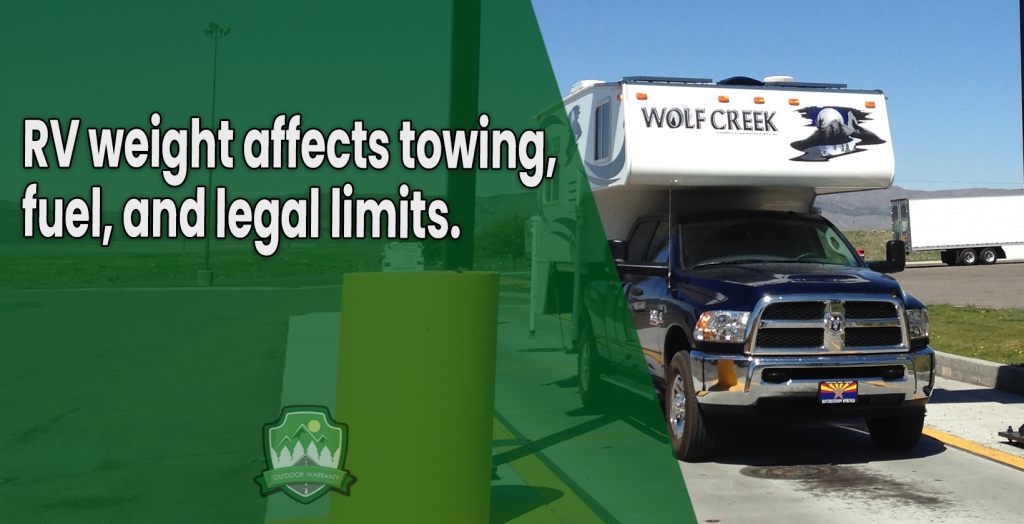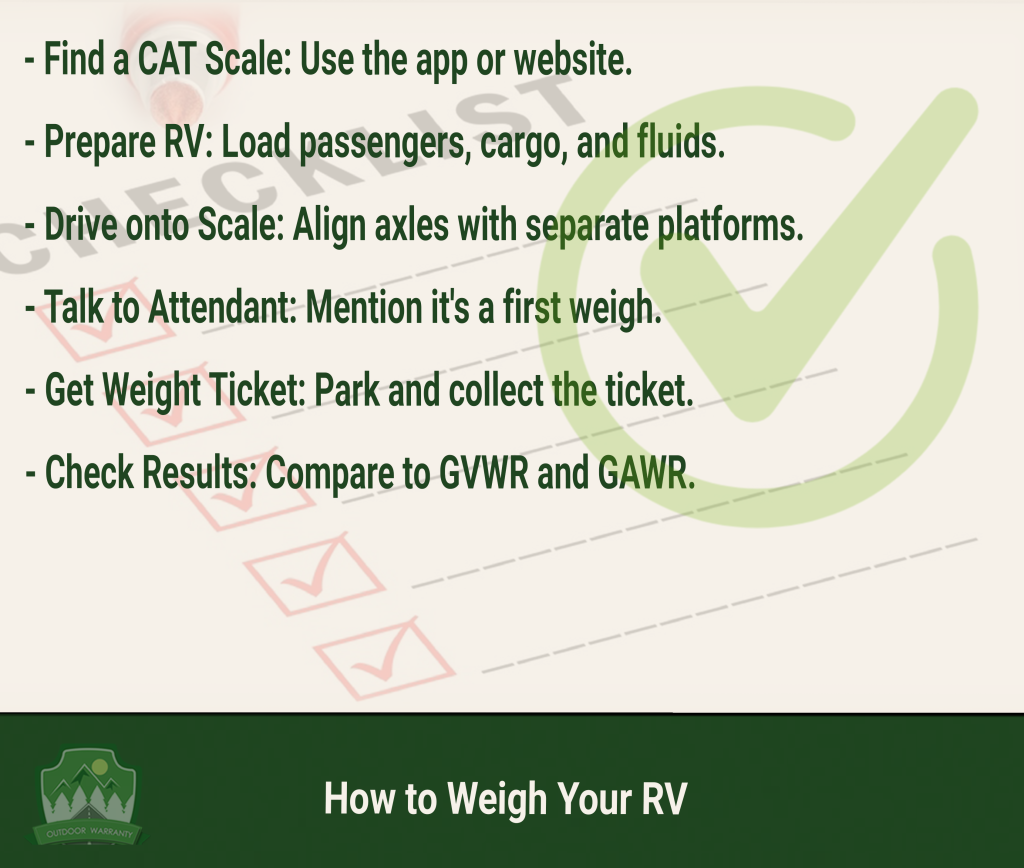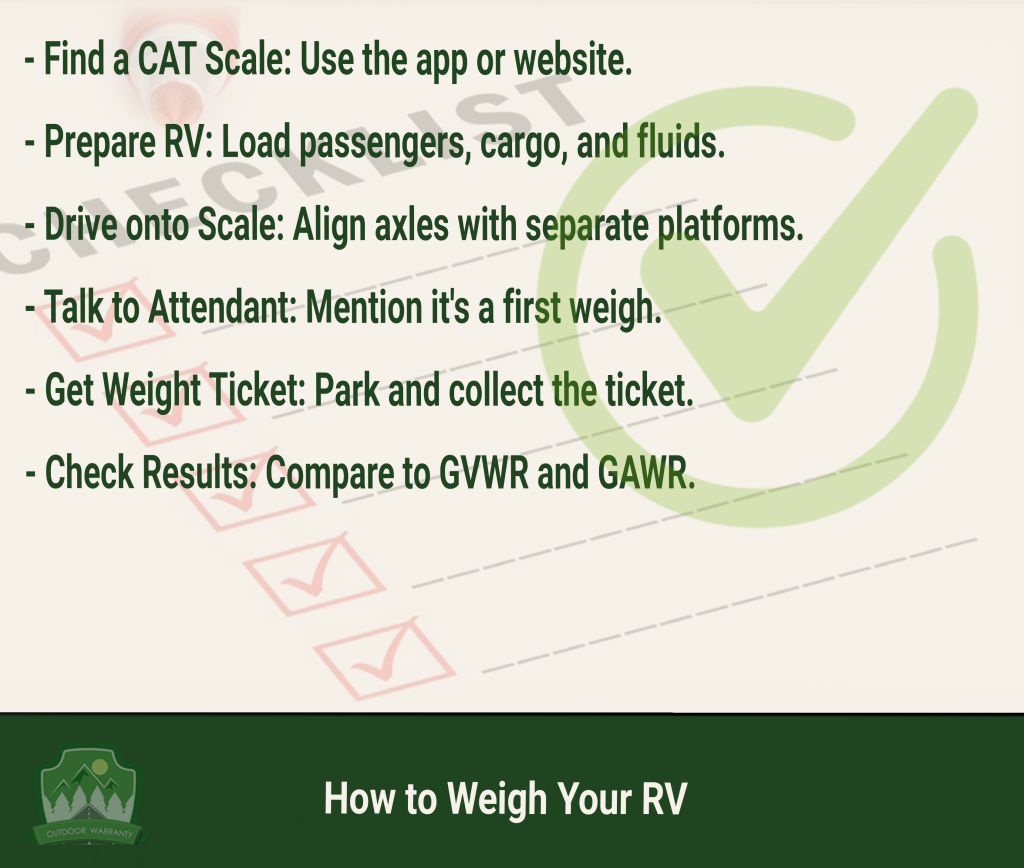
Table of Contents
An RV weighs from 1,000 to 30,000+ pounds depending on its class and size, with the average RV weight falling around 10,000 pounds. Class A motorhomes are the heaviest at 13,000 to 30,000 pounds, Class Cs weigh 10,000 to 12,000 pounds, Class Bs range from 6,000 to 8,000 pounds, while towables vary with fifth wheels at 7,000 to 20,000 pounds, travel trailers at 3,700 to 7,000 pounds, and pop-up campers being lightest at 1,300 to 3,000 pounds.
The RV weight matters because it directly affects fuel economy, handling safety, legal compliance, and mechanical longevity. Proper weight management prevents costly fines at weigh stations, avoids voided warranties, reduces insurance premiums, and prevents tire blowouts or suspension failures. Understanding load limits through Certified Automated Truck Scale (CAT) weighing ensures safe operation within manufacturer specifications, while factors like construction materials, slide-outs, and amenities impact final weight. Lightweight options using aluminum and fiberglass offer fuel-efficient alternatives for owners concerned about towing capacity or fuel costs.
How much does an RV weigh?
RV weight varies depending on type, size, and added features, with some models weighing 1,500 lbs (680 kg) and others exceeding 30,000 lbs (13,608 kg).
RV Type | Typical Weight Range (GVWR) | Weight Factors to Consider |
Travel Trailer | 3,700 to 7,000 lbs (1,361 to 3,175kg) |
|
Fifth Wheel | 7,000 to 20,000 lbs (3,175 to 9,072 kg) |
|
Class A Motorhome | 13,000 to 30,000 lbs (5,897 to 13,608 kg) |
|
Class B Motorhome | 6,000 to 8,000+ lbs (2,722 to 3,629 kg) |
|
Class C Motorhome | 10,000 to 12,000+ lbs (4,536 to 5,443 kg) |
|
Pop-Up Camper | 1,000 to 3,000 lbs (454 to 1,361 kg) |
|
Truck Camper | 1,500 to 4,000 lbs (860 to 1,814kg) |
|
Size, construction materials, and added features influence RV weight. Class C RV weight varies based on engine power and storage capacity, while Class B RV weight depends on conversion features and chassis type. The answer to “how much does a 40 ft RV weigh” depends on its classification, but most Class A motorhomes weigh between 13,000 to 30,000 lbs (5,897 to 13,608 kg). Proper weight management is essential for road safety, fuel efficiency, and a stable driving experience.
Why does RV Weight Matter?
RV weight matters because it directly impacts fuel efficiency, handling, and safety. Heavier recreational vehicles consume more fuel, increasing operational costs and environmental impact. Excessive weight strains the engine and transmission, leading to mechanical failures. Proper weight distribution is essential for safe handling, but an unbalanced or overloaded RV experience poor maneuverability and an increased risk of accidents.
Adhering to legal weight limits is required to avoid penalties and ensure road safety. Weight regulations in the United States differ by state, while federal law limits the maximum gross vehicle weight to 80,000 pounds. Exceeding the limit results in substantial fines, and the extent of the violation.
Fines range from $73 for exceeding the weight limit by 2,000 pounds or less to over $3,000 for exceeding 18,000 pounds. Overloading leads to financial penalties and accelerates wear and tear on tires, suspension, and braking systems, compromising the vehicle’s overall performance and safety. Managing the weight of a recreational vehicle is important for compliance with regulations and maintaining optimal functionality.
How much does a Camper Weigh?
A camper’s weight varies based on type and size, and a towable or motorized recreational unit for travel and camping. Common types include pop-up campers, which have collapsible walls for easy transport and weigh between 1,000 to 3,000 pounds. Truck campers are compact units mounted onto pickup truck beds, ranging from 1,500 to 4,000 pounds. Lightweight travel trailers are non-collapsible towable units weighing between 3,000 to 7,000 pounds.
Fifth-wheel trailers are larger towable campers requiring a specialized hitch in a truck bed, weighing between 10,000 to 20,000 pounds. Teardrop trailers are small, aerodynamic campers that weigh 500 to 3,000 pounds, designed for minimalistic travel. Each type’s weight, size, and features influence towing requirements and fuel efficiency.
Optional features like slide-outs, upgraded appliances, and larger water tanks increase the total weight. The answer to “how much does a 20 ft camper weight” depends on its build and features, but it falls between 2,500 to 5,000 pounds, while an average camper weight for a midsize travel trailer is around 5,000 to 8,000 pounds. The answer to “how much does a 30 foot camper weigh” For larger models is influenced by additional amenities and construction materials, with weights ranging from 7,000 to 12,000 pounds. Heavier campers reduce fuel efficiency, increase strain on the engine and transmission, and affect handling. Overloaded campers experience poor maneuverability and a higher risk of accidents.
Overloading contributes to rapid tire wear, suspension strain, and reduced braking performance, increasing maintenance costs and safety hazards. Proper weight management ensures compliance with regulations and improves the performance of a Camper Trailer on the road.

How much does a Motorhome Weigh?
A motorhome weigh varies based on class, which determines size and features. Class A motorhomes are the largest, built on bus-like chassis, and offer extensive amenities. Class B motorhomes are compact and built on standard van chassis. Class C motorhomes are mid-sized, recognizable by their over-cab sleeping areas, and constructed on truck or van cutaway chassis.
Weight ranges differ among the classes. Class A motorhomes weight between 13,000 to 30,000 pounds. Class B motorhomes range from 6,000 to 8,000 pounds. Class C motorhomes fall between 10,000 to 12,000 pounds. Length, construction materials, and engine size influence a motorhome’s weight. Longer motorhomes accommodate more amenities, increasing overall weight.
Using heavier materials, like solid wood cabinetry, adds weight, while lightweight composites help reduce it. Larger engines, for propelling heavier motorhomes, contribute additional weight. Important to account for the factors to ensure proper handling and compliance with weight regulation, when considering a Class A Motorhome.
What is the Proper Distribution of RV Weight?
The proper distribution of RV weight is achieved through balanced loading that maintains 60% of weight in the front half for towables and even side-to-side distribution for all RVs. Front-to-back balance prevents dangerous swaying and improper tongue weight, while side-to-side balance prevents leaning in the travel.
Axle weight limits must be respected by distributing heavy items low and centered over axles, never exceeding manufacturer specifications for each axle. Kitchen appliances, water tanks, and heavy gear must be positioned directly above or slightly forward of axles when possible. Improper weight distribution leads to trailer sway, poor handling, uneven tire wear, and increased rollover risk, in emergency maneuvers or crosswinds. Regular weighing at certified scales helps RV owners maintain proper distribution for optimal safety and performance.
How to Weigh your RV?
- Locate a CAT Scale: Use the app or website for a Certified Automated Truck Scale (CAT).
- Prepare the RV: Load the RV, including passengers, cargo, and fluids. It ensures the weight measurement reflects real-world conditions.
- Enter the Scale: Drive onto the scale slowly, aligning the vehicle with each axle on a separate platform. The front or steer axle goes on platform one, the rear or drive axle on platform two, and the trailer axle on platform three.
- Communicate with the Attendant: Press the intercom button and inform the attendant that a first weigh is being performed. The attendant asks for a truck number, if the person is a private RV owner, simply state “private.”
- Obtain the Weight Ticket: Pull off the scale and park safely. Go inside the truck stop to retrieve the weight ticket, which details the weight of each axle and the total gross weight.
- Review and Interpret the Results: Compare the recorded weights to the RV’s Gross Vehicle Weight Rating (GVWR) and Gross Axle Weight Ratings (GAWR) to ensure the vehicle is within safe operating limits.

What are the Consequences of Overloading Your RV?
The consequences of overloading an RV are severe mechanical failures, legal penalties, and dangerous handling problems. Overloaded RVs experience accelerated brake wear leading to potential failure, suspension component damage including broken springs or shocks, and increased risk of catastrophic tire blowouts due to excessive heat and pressure.
Legal consequences include fines ranging from $100 to $10,000 depending on jurisdiction and violation severity, manufacturer warranties becoming void when weight ratings are exceeded, and insurance denying accident claims. Insurance providers investigate weight as a contributing factor after accidents.
Handling deteriorates with poor turn stability, dangerous swaying in crosswinds, and gradually increased stopping distances. Most Extended Warranties of RVs specifically exclude coverage for damage resulting from overloading, leaving owners fully responsible for costly repairs. RV warranties do not cover accidents or damage caused by exceeding manufacturer weight ratings, as it constitutes improper vehicle use.
What Factors Influence the Weight of an RV?
Factors influencing the weight of an RV are listed below.
- Construction Materials: Construction materials play a role in overall weight. Aluminum frames are lightweight and durable, reducing total weight, improving fuel efficiency, and making towing easier. Aluminum provides less insulation than other materials, affecting temperature control. Fiberglass is heavier but more aerodynamic, offering better insulation and durability. It resists dents and corrosion, making it a preferred option for high-end RVs.
- Slide-Outs: Slide-outs increase interior space but add weight due to extra framing, motors, and insulation. More slide-outs require a stronger suspension and frame, which affects fuel efficiency and handling.
- Appliances: Appliances contribute to the total weight, if they are residential-sized. Standard RV appliances such as refrigerators, ovens, and microwaves add to the load, while heavier appliances like full-size refrigerators or washer-dryer units require additional power and structural support.
- Furniture: Furniture affects weight, mainly from solid wood or heavy covering. Built-in furniture increases the total load, while lightweight materials like composite wood and aluminum frames help reduce weight while maintaining durability.
- Water and Fuel Tanks: Water and fuel tanks add weight when full. A gallon of water weighs 8.3 pounds, meaning a 50-gallon tank adds over 400 pounds. Fuel tanks for gas or diesel, increase weight in motorized RVs with large-capacity tanks.

How does the Weight of an RV Affect its Towing Capacity?
The weight of an RV affects its towing capacity by directly impacting the vehicle’s ability to safely pull and control loads within manufacturer specifications. GVWR (Gross Vehicle Weight Rating) represents the maximum allowable weight of the fully-loaded tow vehicle, while GCWR (Gross Combined Weight Rating) indicates the maximum allowed weight of the tow vehicle and trailer combined, establishing the ultimate towing limit.
Tongue weight is 10 to 15% of the trailer’s total weight. It is critical for towing safety as it creates downward force on the hitch, preventing dangerous trailer sway and maintaining stability in travel. Insufficient tongue weight causes trailer swaying, while excessive tongue weight overloads the tow vehicle’s rear axle.
Overloading beyond capacity forces engines to work harder at higher temperatures, accelerating wear on transmission components through excessive heat buildup, premature fluid breakdown, and increased clutch slippage. The strain affects the cooling system, braking performance, and suspension components, leading to mechanical failures and reduced service life of the towing vehicle.
Are there any Lightweight RV Options Available?
Yes, there are lightweight RV options available that provide more fuel-efficient and easier towing alternatives to traditional recreational vehicles. Teardrop trailers weigh 1,000 to 2,000 pounds, while ultralight travel trailers range from 3,000 to 7,000 pounds, with manufacturers like Scamp offering 13-foot models under 1,500 pounds and Airstream producing Basecamp models around 2,600 pounds.
The lightweight RVs utilize aluminum framing, fiberglass composite shells, and vacuum-bonded lamination techniques to reduce weight while maintaining structural integrity. Manufacturers incorporate lightweight synthetic countertops, compact appliances, and minimalist furniture to minimize mass. Buyers must recognize trade-offs, including less storage space, smaller water tanks, reduced insulation affecting temperature regulation, and limited amenities compared to heavier models. Lightweight designs offer excellent portability and fuel efficiency, but they do not provide the same level of durability against harsh conditions or extensive off-grid capabilities found in heavier RVs.
How do Different Classes of RVs Compare in Terms of Weight?
Different classes of RVs compare in terms of weight with Class A motorhomes being the heaviest at 13,000 to 30,000 pounds, followed by Class C motorhomes at 10,000 to 12,000 pounds, and Class C RV weight ranges fall between 10,000 to 14,000 pounds. Class B RV weight is lighter at 6,000 to 8,000 pounds, making them the most fuel-efficient and most manageable to drive among motorized RVs.
Fifth wheels range from 7,000 to 20,000 pounds, conventional travel trailers weigh 3,000 to 7,000 pounds, and pop-up campers are the lightest option at 1,000 to 3,000 pounds. Weight increases proportionally with length and width dimensions, with each additional foot adding 300 to 500 pounds. More powerful engines and drivetrain components, such as diesel pushers, add weight. Luxury amenities impact overall weight, with full residential refrigerators adding 300+ pounds, washer/dryer combinations contributing 200+ pounds, and slide-out rooms adding 500-1,000 pounds to the RV’s total weight.
What are the Heaviest RVs On the Market?
The heaviest RVs on the market are listed below.
- Holiday Rambler Navigator: The Holiday Rambler Navigator is a Class A motorhome with a diesel engine and reinforced chassis. It features marble countertops and residential furniture, increasing its weight. Maneuvering the RV requires air brakes and a suspension system capable of handling heavy loads.
- Forest River Cardinal Luxury: Forest River Cardinal Luxury is a high-end fifth-wheel trailer with solid wood cabinetry, and full-size kitchen appliances. Multiple slide-outs expand living space but add considerable weight, requiring a high-powered towing system. A one-ton dually truck with a fifth-wheel hitch is essential for stable towing.
- Crossroads Redwood 4200FL: Crossroads Redwood 4200FL is a premium RV with a king-size bed, fireplace, and spa-style bathroom. Its reinforced frame and oversized holding tanks increase the weight, making it suitable for full-time living. Safe transport demands an upgraded suspension and a powerful diesel truck.
- Luxe Elite 46RKB: Luxe Elite 46RKB is a top-tier luxury fifth-wheel with features like quartz countertops, a walk-in closet, and dual-pane windows for improved insulation. The added weight impacts fuel efficiency and braking performance, requiring a properly rated tow vehicle. Towing the RV safely requires an advanced hitch system and a truck with high torque output.
- Brinkley Model Z: Brinkley Model Z is a modern trailer with aluminum construction and heavy-duty axles to support its high-end amenities. It includes a full-sized refrigerator and an extended kitchen island, contributing to its overall mass. Its weight demands tires and a truck with an upgraded cooling system for long-distance towing.
- Jayco Embark: Jayco Embark is a Class A diesel motorhome built for luxury travel with residential-grade flooring, a washer/dryer setup, and a whole entertainment system. Its heavy-duty construction and large fuel tank increase total weight. Drivers need a special license, depending on local laws for motorhomes exceeding weight limits.
- Entegra Coach Cornerstone: Entegra Coach Cornerstone is a Class A motorhome featuring heated tile floors, a walk-in shower, and top-of-the-line furniture. The additional weight affects acceleration and requires a powerful diesel engine for smooth operation. Handling the RV involves experience with air ride suspension and advanced braking systems.
- Luxe Elite Fifth Wheels: Luxe Elite Fifth Wheels is a fifth-wheel for full-time living with high-end materials such as granite countertops and stainless steel appliances. Adding weight increases stress on the axles and hitch connection, making proper weight distribution crucial. A truck with a frame and a high-capacity tow package is required for safe towing.
- Newmar King Aire: Newmar King Aire is a large Class A motorhome with features such as a gourmet kitchen, a residential-sized shower, and premium seating. The structural weight and additional cargo reduces fuel efficiency and requires frequent maintenance. Safe operation requires an engine with high torque and a suspension system capable of handling heavy loads.
- DRV Mobile Suites 44 Houston: DRV Mobile Suites 44 Houston is a fifth-wheel trailer built for extended stays, featuring multiple slide-outs, a full kitchen, and residential-style furniture. Its increased weight strains tires and suspensions, requiring regular inspections and maintenance. Towing the RV requires a truck with a dual rear-wheel setup and a properly rated fifth-wheel hitch.

Is RV Insurance Premium Based on The Weight?
Yes, RV insurance premiums are based on weight because heavier RVs represent higher value, increased potential for damage, and greater liability risk. Insurance companies factor weight into their calculations as heavier vehicles cause more damage in accidents, require more expensive repairs due to specialized parts and labor, and present higher risk profiles.
Weight is a proxy for size and value, with Class A motorhomes weighing 13,000 to 30,000 pounds commanding higher premiums than 6,000 to 8,000 pound Class B vehicles. Providers like Outdoor Warranty use weight classifications alongside other factors like usage patterns, storage location, and driving history to determine Insurance for the RVs.